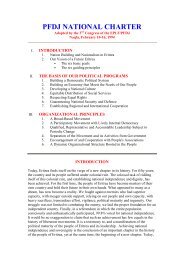Common Country Assessment (CCA) - ECSS | Eritrean Center for ...
Common Country Assessment (CCA) - ECSS | Eritrean Center for ...
Common Country Assessment (CCA) - ECSS | Eritrean Center for ...
Create successful ePaper yourself
Turn your PDF publications into a flip-book with our unique Google optimized e-Paper software.
4.6 Health and Nutrition<br />
Preliminary<br />
• Notable progress has been made towards improving the health status of the population especially in the post war period. The health facilities previously damaged have been repaired and new<br />
ones constructed; more health personnel have been trained; and a steady supply of drugs and other requisites has been maintained. The result is that Eritrea is on track to achieve the MDGs<br />
relating to child and maternal mortality and malaria. Health facility data <strong>for</strong> 2003 indicate that non-communicable diseases such as hypertension, diabetes mellitus and liver diseases are on the<br />
increase, a reflection of increasing urbanization and lifestyle changes. However, communicable diseases remain the overwhelming cause of morbidity and mortality. Malnutrition is a serious<br />
problem in Eritrea. It is a health-related issue but it cuts across many sectors. A fistula needs assessment study conducted in 2003 revealed a significant prevalence of this condition,<br />
highlighting the risks of adolescent pregnancy, early marriage and inadequate safe motherhood services.<br />
Progress made towards national priorities<br />
• Over the past five years Eritrea has scored successes on a wide front in the health sector. As presented in the 2004 MDGR, the progress described earlier has translated into the following:<br />
- Mortality among children under five years of age fell from 136 deaths per 1,000 live births during 1993-9 to 93 in 2001-03.<br />
- Infant mortality declined from 72 deaths per 1,000 live births to 48 over the same period.<br />
- Maternal deaths per 100,000 live births during 1993-95 were put at 983 and are estimated to have dropped to about 581 during 2001-03.Health facility data, which do not give a full picture<br />
of deliveries in the country, yielded a maternal mortality ratio of 230 <strong>for</strong> 2001-03.<br />
- The number of outpatient and inpatient cases of malaria per 1,000 was 22 in 2001-03; comparable data are not available <strong>for</strong> the 1993-95 period. Malaria deaths in health facilities declined<br />
sharply from a little over 400 in 1998 to 16 deaths in 2004.<br />
• The gains can be attributed to a number of factors. One important factor is the extensive health infrastructure that has been constructed all over the country. This has improved access to<br />
trained health personnel and medicines considerably. The second factor is the focus on primary health care. In practice, this focus has translated into programs aimed at addressing the main<br />
communicable diseases: malaria, HIV/AIDS, TB and the vaccine-preventable diseases.<br />
• The third factor is the significant level of support from the development partners. No other sector has received sustained support on a scale comparable to that of health. With regard to<br />
communicable diseases, key factors are improved case management skills of health workers, effective environmental control measures, the use of insecticide treated mosquito nets and<br />
improvement in the health-seeking behaviour of the population.<br />
• Furthermore, food supplementation provided to children through collaboration between Health and Education sectors and the multiplicity of partners active against the practice of FGM have<br />
been instrumental in saving the lives of women and children and the modest decline in the incidence of FGM, most noticeable in young people.





